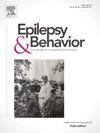成人癫痫患者疲劳的决定因素:我们应该只关注抗癫痫药物的作用吗?
IF 2.3
3区 医学
Q2 BEHAVIORAL SCIENCES
引用次数: 0
摘要
疲劳是癫痫(PWE)患者常见的症状,但尚未得到充分的研究。我们的目的是调查PWE中与疲劳相关的因素,特别关注抗癫痫药物(ASM)的使用。方法对成年门诊患者进行匿名横断面调查,要求他们完成疲劳量表(疲劳严重程度量表,FSS)、焦虑症状量表(广泛性焦虑障碍-7,GAD-7)、抑郁量表(癫痫神经障碍抑郁量表,NDDI-E)的评估,并提供不良反应(利物浦不良事件档案,LAEP)、药物类型、数量、依从性和自我报告的治疗效果的数据。组间比较采用独立样本t检验和Mann-Whitney U检验(两组),组间比较采用方差分析和Kruskal-Wallis检验(两组以上)。对疲劳的影响因素进行了相关分析和线性多元回归分析。敏感性分析采用多重输入来解释缺失数据。结果本研究共纳入232例PWE,其中女性130例(56.0%),平均年龄39.1±14.7岁,完成FSS的PWE 190例(81.9%),其中40.5%报告有明显的疲劳症状(FSS评分≥4)。FSS评分较高的患者性别为女性(t = -2.086, p = 0.038),癫痫发作频率较高(r = 0.183, p = 0.020),在过去一个月内缺少至少一次asm (t = 2.491, p = 0.014),焦虑症状(GAD-7, r = 0.510, p <;0.001),抑郁(NDDI-E, r = 0.453, p <;0.001)和不良的ASM概况(LAEP, r = 0.565, p <;0.001)。FSS评分与自我报告的癫痫治疗效果呈负相关(r = -0.277, p <;0.001),并且与ASM计数、使用时间、ASM方案的近期变化、不遵守的频率或合用药物的使用无关(p >;0.05)。FSS评分在基于特定ASM使用的亚组之间也没有差异。在多元回归模型中,不良反应(LAEP)、焦虑症状(GAD-7)和主观感知的当前治疗效果是与FSS结果相关的独立因素(F(3,130) = 27.310, p <;0.001, Radj2 = 0.372)。结论PWE患者的疲劳主要与焦虑症状、不良反应和自我报告的治疗效果有关。无论asm的类型和次数如何,特别注意自我报告的耐受性和疗效,以及心理症状,可以帮助PWE在调整治疗时减少疲劳。本文章由计算机程序翻译,如有差异,请以英文原文为准。
Determinants of fatigue among adults with epilepsy: Should we focus solely on antiseizure medication effects?
Introduction
Fatigue is a frequent, albeit underexplored symptom among people with epilepsy (PWE). We aimed to investigate factors associated with fatigue among PWE with a special focus on antiseizure medication (ASM) use.
Methods
We conducted an anonymous cross-sectional survey among adult outpatients asking them to complete instruments assessing fatigue (the Fatigue Severity Scale, FSS), symptoms of anxiety (Generalized Anxiety Disorder-7, GAD-7), depression (Neurological Disorders Depression Inventory for Epilepsy, NDDI-E) as well as provide data on adverse ASM effects (Liverpool Adverse Events Profile, LAEP), medication type, number, adherence and self-reported treatment efficacy. Independent-samples t-test and Mann-Whitney U test (two groups) or analysis of variance and Kruskal-Wallis tests (more than two groups) were used for between-group comparisons. Correlation and linear multiple regression analysis was done in search of factors associated with fatigue. Multiple imputation was used for sensitivity analysis to account for missing data.
Results
The study sample comprised 232 PWE (130 (56.0 %) female, average age 39.1 ± 14.7 years) with 190 (81.9 %) PWE having completed the FSS and 40.5 % among them reporting clinically significant fatigue (FSS score ≥ 4). Higher FSS scores were associated with female sex (t = –2.086, p = 0.038), higher seizure frequency (r = 0.183, p = 0.020), missing at least one dose of ASMs in the past month (t = 2.491, p = 0.014), symptoms of anxiety (GAD-7, r = 0.510, p < 0.001), depression (NDDI-E, r = 0.453, p < 0.001) and adverse ASM profile (LAEP, r = 0.565, p < 0.001). The FSS score was inversely related to self-reported efficacy of epilepsy treatment (r = –0.277, p < 0.001) and independent of the ASM count, duration of use, recent changes in ASM regimen, frequency of non-adherence or the use of concomitant medications (p > 0.05). FSS scores also did not differ across subgroups based on specific ASM use. Adverse ASM effects (LAEP), symptoms of anxiety (GAD-7) and the subjectively perceived efficacy of current treatment were independent factors associated with results of the FSS in a multiple regression model (F(3, 130) = 27.310, p < 0.001, = 0.372).
Conclusion
Our data suggests that fatigue among PWE is mostly associated with symptoms of anxiety, adverse ASM effects and self-reported treatment efficacy. Regardless of the type and count of ASMs, special attention to self-reported tolerability and efficacy, alongside psychological symptomatology, could help to reduce fatigue among PWE when adjusting treatment.
求助全文
通过发布文献求助,成功后即可免费获取论文全文。
去求助
来源期刊

Epilepsy & Behavior
医学-行为科学
CiteScore
5.40
自引率
15.40%
发文量
385
审稿时长
43 days
期刊介绍:
Epilepsy & Behavior is the fastest-growing international journal uniquely devoted to the rapid dissemination of the most current information available on the behavioral aspects of seizures and epilepsy.
Epilepsy & Behavior presents original peer-reviewed articles based on laboratory and clinical research. Topics are drawn from a variety of fields, including clinical neurology, neurosurgery, neuropsychiatry, neuropsychology, neurophysiology, neuropharmacology, and neuroimaging.
From September 2012 Epilepsy & Behavior stopped accepting Case Reports for publication in the journal. From this date authors who submit to Epilepsy & Behavior will be offered a transfer or asked to resubmit their Case Reports to its new sister journal, Epilepsy & Behavior Case Reports.
 求助内容:
求助内容: 应助结果提醒方式:
应助结果提醒方式:


